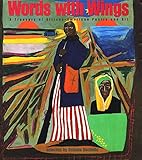Lesson 2: The Tone of a Poem
Lesson Plan
Words with Wings: A Treasury of African-American Poetry and Art

- Learning Goal
- Describe the emotion or tone of a poem.
- Duration
- Approximately 2 Days (35-40 minutes for each class)
- Necessary Materials
- Provided: Voice Teacher Example Chart 1, Voice Teacher Example Chart 2, Voice Worksheet (Student Packet, page 10)
Not Provided: Chart paper, markers, Words With Wings selected by Belinda Rochelle
-
Before the Lesson
Read the poems and complete the Student Packet Worksheets for “Women,” “Those Winter Sundays,” “Listen Children,” and “Fifth Grade Autobiography.”
-
Activation & Motivation
Show students two works of art from Words with Wings: “Thankful Poor” by Henry Ossawa Tanner and “Celebration” by Charles Searles. Ask students: "When you look at each piece of artwork, how does it make you feel?" Encourage discussion among the class. Ask: "What is it about the paintings that make you feel this way? (Color, subjects, etc.) How do your feelings differ about each work of art?"
-
Teacher Modeling

will explain that just like art conveys a strong emotion, so does poetry. While art uses colors, shades, and the subject to evoke a feeling, poetry uses words and language to evoke a feeling. I will define the tone or voice of a poem as the mood that influences a reader’s emotional response to a poem. Tone sets the stage for how the reader feels while reading. I will explain that in order to describe the tone or voice of a poem, good readers look at the words and phrases the poet uses.
I will read aloud the poem “Incident.” NOTE: In the poem, “Incident” the word “nigger” is used. If you feel your class is not ready for this content, you may replace this poem with “Auction Street.” After I’ve read the poem once, I will immediately write down any emotions I felt while reading the poem on Voice Chart 1. After reading the poem, I’m sad for the child who remembers this incident. Another part of me feels angry because this incident happened. I will write angry and sad on my chart. Note: See the Voice Teacher Example Chart 1 for specific examples.
Next, I will go back and underline words or phrases that led me to feel sad or angry. The first two lines in the first stanza of the poem actually makes me feel happy and hopeful. But the next two lines start to make me uneasy. I feel uneasy that a Baltimorean is looking at the child. The last two lines of that stanza make me shocked, upset, sad, and angry because this child calls the narrator a “Nigger.” The poet likely used this word to provoke a strong emotion from the reader because the word is associated with strong and negative feelings. The final stanza of the poem also makes me feel sad, because the child, even though he stayed in Baltimore for eight months, only remembers this degrading incident. The poet purposely closes the poem with this statement so that readers can feel an emotion about the “incident.”
Now I can draw a conclusion about the overall tone or voice of the poem. The overall emotion is anger and sadness, and the words and phrases I have underlined have driven me to that emotion. Poems are meant to be read aloud, so I will read “Incident” aloud using a sad tone, since I now know that this is how the poet wants the work to be read. (Engage students in an informal discussion about how reading the poem with an opposite tone would make the poem feel very different, perhaps even changing the meaning of the poem. For example, if “Incident” was read in a cheerful voice, it would make the poem seem odd or wrong. Voice is important in properly understanding the poem.)
-
Think Check
Ask: "How can I figure out the emotion or tone of a poem?" Students should respond that you can look for words or phrases that are meant to elicit an emotional response from the reader. You can make notes about how you feel as you reread the poem, and then use the notes to draw a conclusion about the overall feeling from the poem. Finally, you can read the poem aloud using the tone and emotion that was felt from the poem.
-
Guided Practice

will identify the tone of the poem “Night” by E. Ethelbert Miller. Note: You may want to write the poem on chart paper or the board before the lesson so students can refer to the lines of the poem. We will read the poem aloud once through. Next, we will immediately write down our initial reaction to the poem. We will write these feelings on Voice Chart 2. Note: See the Voice Teacher Example Chart 2 for reference. We will write down the words and phrases that evoke feelings in us. We will draw a conclusion about how the poem makes us feel and what words or phrases in the poem make us feel this way. We will reread aloud “Night” with the specific tone we have identified.
-
Independent Practice

will read “Those Winter Sundays” by Robert Hayden. You will use your Voice Worksheet in your Student Packet to write your feelings about the poem. (See page 10 in the Student Packet.) You will then go back and identify the words and phrases that support your thinking.
-
Reflective Practice

will come together to share our findings about the tone of the poem. We will reread “Those Winter Sundays” aloud with the tone we have identified.
Texts & Materials
Standards Alignment
(To see all of the ReadWorks lessons aligned to your standards, click here.)


